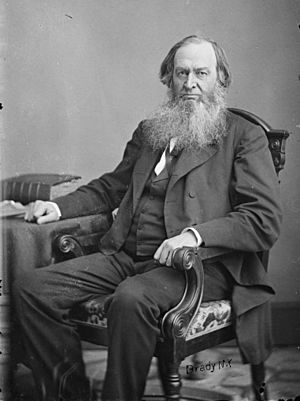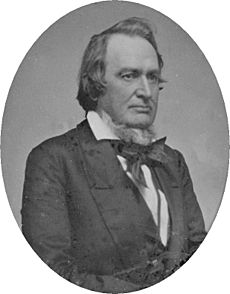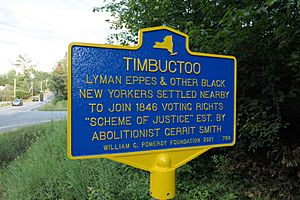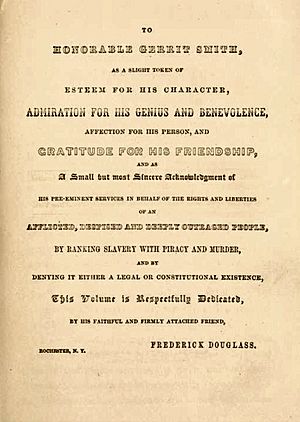Gerrit Smith facts for kids
Quick facts for kids
Gerrit Smith
|
|
|---|---|
 |
|
| Member of the U.S. House of Representatives from New York's 22nd district |
|
| In office March 4, 1853 – August 7, 1854 |
|
| Preceded by | Henry Bennett |
| Succeeded by | Henry C. Goodwin |
| Personal details | |
| Born | March 6, 1797 Utica, New York |
| Died | December 28, 1876 (aged 79) New York City |
| Political party | Liberty (1840s) Free Soil (1850s) |
| Spouses | Wealtha Ann Backus (Jan. 1819 – Aug. 1819; her death) |
| Children | Elizabeth Smith Miller and Greene Smith |
| Occupation | social reformer, abolitionist, politician, philanthropist |
Gerrit Smith (March 6, 1797 – December 28, 1874) was a very important American social reformer, abolitionist, politician, and philanthropist. A social reformer works to make society better. An abolitionist wanted to end slavery. A philanthropist is someone who gives a lot of money to good causes.
Smith was married to Ann Carroll Fitzhugh. He ran for President of the United States three times (in 1848, 1856, and 1860). However, he only won an election once, serving a single term in the House of Representatives from 1853 to 1854.
Gerrit Smith was one of the richest men in New York State and in the entire country. He used a lot of his money to support the Liberty Party and the Republican Party. He spent much of his life and wealth working for social progress. He gave land and money to create Timbuctoo, a community for African Americans in North Elba, New York. He also supported the temperance movement, which aimed to reduce alcohol use. He was involved in the colonization movement at first, which suggested sending free Black people to Africa. But he later changed his mind and became a strong supporter of abolitionism, which meant freeing all enslaved people immediately. He was also part of a group called the Secret Six, who helped pay for John Brown's raid in 1859. John Brown's farm in North Elba was on land he bought from Smith.
Contents
Early life and family
Gerrit Smith was born in Utica, New York. His father, Peter Gerrit Smith, was a very wealthy man and the biggest landowner in New York State. Peter Smith made a lot of money from the fur trade and real estate. He was also a judge and a very religious man.
Gerrit's father gave him a large business in 1819. When his father died in 1837, Gerrit inherited even more money and land. At one point, Gerrit Smith owned about 750,000 acres of land, which is bigger than the state of Rhode Island!
Gerrit Smith's aunt was married to Judge Daniel Cady. Their daughter, Elizabeth Cady Stanton, was Gerrit's first cousin. Elizabeth Cady Stanton later became a famous leader in the women's suffrage movement, fighting for women's right to vote. She met her future husband, Henry Brewster Stanton, who was also an abolitionist, at the Smith family home in Peterboro, New York. Gerrit moved to Peterboro when he was nine years old.
Gerrit as a young man
Gerrit Smith was described as a tall and strong man. He went to Hamilton College and graduated with honors in 1818. He got married in 1819 to Wealtha Ann Backus, but she sadly died that same year. In 1822, he married Ann Carroll Fitzhugh. They had eight children, but only two, Elizabeth Smith Miller and Greene Smith, lived to be adults.
When Gerrit's mother died, his father became very sad and stopped working. So, Gerrit had to take over the family business, which was huge. He had planned to become a lawyer, but he gave up that dream to manage his family's wealth.
Gerrit also became very active in the temperance movement. He gave speeches against alcohol and even built one of the first temperance hotels in the country in his hometown of Peterboro.
Gerrit's journey to abolitionism
In the 1830s, Gerrit Smith became more involved in social causes. He thought about starting a school for Black students. In 1834, he opened a school for Black students in Peterboro, but it only lasted one year.
At first, Smith supported the American Colonization Society, which wanted to send free Black people to live in Liberia, Africa. However, he soon realized that this group did not truly want to end slavery. In 1835, he became a strong abolitionist, meaning he wanted slavery to end immediately. This happened after a group of people in Utica broke up a meeting of the New York Anti-Slavery Society. Smith invited the meeting to continue at his home in Peterboro. He even left his position as a trustee at Hamilton College because he felt the school wasn't doing enough against slavery. He then helped the Oneida Institute, which was a center for anti-slavery activities.
Political career
Gerrit Smith ran for high office many times but rarely won. He was a candidate for president three times and ran for Governor of New York twice.
In 1840, Smith helped create the Liberty Party, which was an anti-slavery political party. In 1848, he was nominated as the Liberty Party's presidential candidate. He gave a big speech where he called for "universal suffrage," meaning everyone should have the right to vote, including women. This was a very advanced idea for his time. The party's platform even included a statement that no nation was truly Christian or civilized enough if it didn't allow women to vote.
The only political office Gerrit Smith was ever elected to was a seat in the U.S. Congress. He served one term, from March 1853 to August 1854, as a member of the Free Soil Party. He said he didn't even want to be nominated or elected because of his business. He resigned his seat on the last day of the session, explaining that he was frustrated with Congress and wanted to go home to his family and business. Even Southern members of Congress, who usually disagreed with abolitionists, liked him.
Smith believed that the U.S. Constitution was actually against slavery, which was different from some other abolitionists who thought it supported slavery. He also believed that all people had an equal right to land, that wars were bad, and that women should have full political rights.
In 1869, Smith was a delegate at the meeting that founded the Prohibition Party, which wanted to ban alcohol.
Support for Black communities
Gerrit Smith was a strong supporter of Black people's rights. A Black minister named Henry Highland Garnet once said that Peterboro, Smith's hometown, was a safe place where slave owners could not come.
The Timbuctoo land project
Smith believed that owning land was important for people to be truly free and to vote in New York. In 1846, he gave away 50-acre farms to 1,000 "worthy" Black families in New York. He hoped this would help them become self-sufficient and safe from slave hunters. This land was in the remote Adirondacks.
However, the land Smith gave away was not very fertile and was covered in thick forests. Smith himself called it his "poorest land." Many people who received the land never even saw it, and most of those who did visit soon left. It was hard to farm in the mountains, and the settlers often lacked experience in building homes and farming. Also, some white neighbors were not welcoming. Because of these challenges, the project largely failed. Today, only the John Brown Farm State Historic Site remains from this settlement, which was called Timbuctoo, New York.
Helping enslaved people escape
Peterboro became a "station" on the Underground Railroad, a secret network that helped enslaved people escape to freedom. Smith used his money to support a plan for a large group of enslaved people to escape from Washington, D.C., in 1848. This event, known as the Pearl incident, gained national attention when the 77 enslaved people were caught.
Smith also paid for the legal costs of several people who were charged with breaking the Fugitive Slave Law of 1850. This law made it illegal to help enslaved people escape.
Supporting John Brown
Smith became a leader in the Kansas Aid Movement, which raised money to help anti-slavery settlers in Kansas. It was during this time that he first met and financially supported John Brown.
Smith was also part of the Secret Six, a group of powerful abolitionists who supported John Brown's plan to capture the armory at Harpers Ferry and start a slave revolt. After the raid failed, Senator Jefferson Davis tried to have Smith arrested and executed along with Brown, but he was not successful. The events around Harpers Ferry deeply affected Smith, and he became very ill for a time.
Other social work
Smith was a major supporter of New York Central College, which was a college that allowed both men and women, and students of all races, to study together.
He supported the American Civil War. But after the war ended, he believed that the Southern states should be treated kindly. He even helped pay the bond to free Jefferson Davis, the former president of the Confederacy, from prison. This made some Northern politicians angry.
Smith also had strong religious beliefs. He thought that different Christian groups should not be separated. In 1843, he left the Presbyterian Church and helped start the Church at Peterboro, which was open to all Christians who did not own slaves.
Gerrit Smith was known for his incredible generosity. He gave away huge amounts of money to help people and good causes. He didn't even keep records of all his gifts, but it's believed he gave away millions of dollars. Even though he was very wealthy, he lived a simple life. He died in 1874 while visiting relatives in New York City.
The Gerrit Smith Estate in Peterboro, New York, is now a National Historic Landmark.
Tribute
Frederick Douglass, a famous abolitionist and former enslaved person, dedicated his book My Bondage and My Freedom (1855) to Gerrit Smith. Douglass wrote that he admired Smith's character, kindness, and friendship. He thanked Smith for his great work in fighting for the rights and freedom of enslaved people.
A student at Smith's school in Peterboro once said that if Black people had a true friend, that friend was Gerrit Smith.
Philanthropic activities
Gerrit Smith supported many progressive causes and people. Here are some examples of his generosity:
- He gave away 200,000 acres of his land to poor people.
- He helped 650 poor women get money to buy homes.
- He built and ran a temperance hotel in Peterboro in the 1820s.
- He supported the Oneida Institute in the 1830s.
- He started a school for Black boys in Peterboro from 1834 to 1836.
- He helped found a church in Peterboro in 1843 that was open to all non-slave-owning Christians.
- He supported Frederick Douglass's anti-slavery newspaper, The North Star, in the late 1840s.
- He provided land for the Timbuctoo settlement for Black farmers in 1848.
- He sold land to John Brown for a very low price.
- He was a major supporter of New York Central College in the 1850s.
- He helped pay for the legal costs of people who broke the Fugitive Slave Law in the 1850s.
- Around 1855, he gave $25,000 to build the Oswego City Library and $5,000 for books.
- He was a leading figure in the Kansas Aid Movement, helping anti-slavery settlers and John Brown make Kansas a free state in the 1850s.
- He paid for the printing of a book called The Roving Editor in 1859.
- He was one of the Secret Six who helped pay for John Brown's raid in 1859.
- He was one of the people who helped pay Jefferson Davis's bond in 1867.
- He supported William G. Allen and his family when they were struggling in London in the 1870s and 1880s.
After his death, a newspaper reported that he gave away fortunes to help people in need. He helped old men and women, helped people buy farms, and sent children to school. He also gave money to help people affected by fires, famines (like the Irish famine), and natural disasters. He supported anti-slavery groups, temperance reformers, teachers, and ministers. He gave money to colleges like Hamilton College, Oneida Institute, Oberlin College, New York Central College, Hampton University, Berea College, Storer College, Fisk University, and Howard University. He even thought about starting a big university for men and women, white and Black, in New York. He also gave money to help poor single women and widows in every county of New York State.
Writings
Gerrit Smith wrote many letters and speeches that shared his ideas on government and social issues.
Images for kids
-
Gerrit Smith house, Peterboro, New York, from an 1878 book. The house was destroyed by fire in 1936.
-
Edmonia Lewis, hands of Gerrit Smith and his wife Ann Carroll Fitzhugh
See also
 In Spanish: Gerrit Smith para niños
In Spanish: Gerrit Smith para niños







